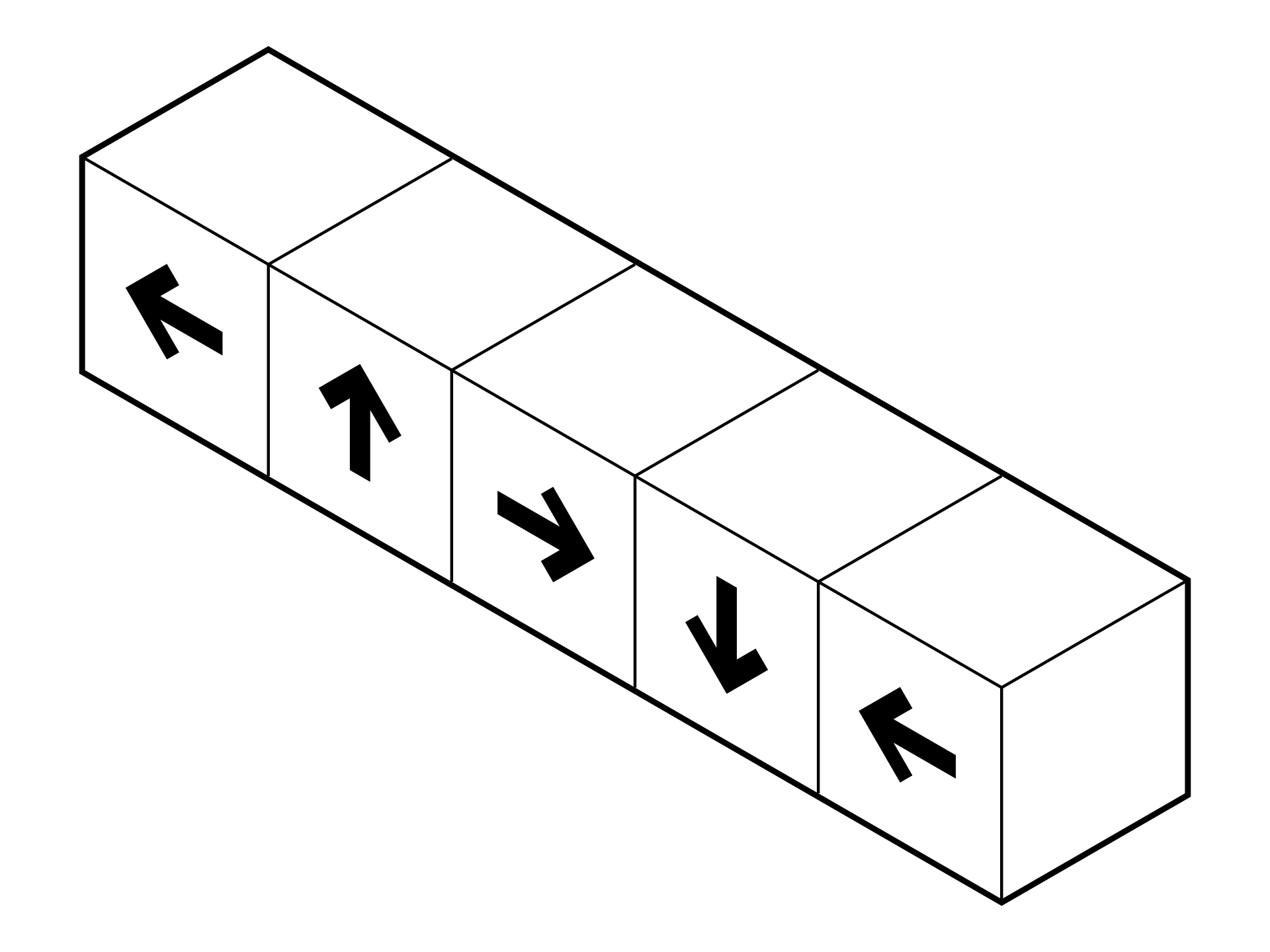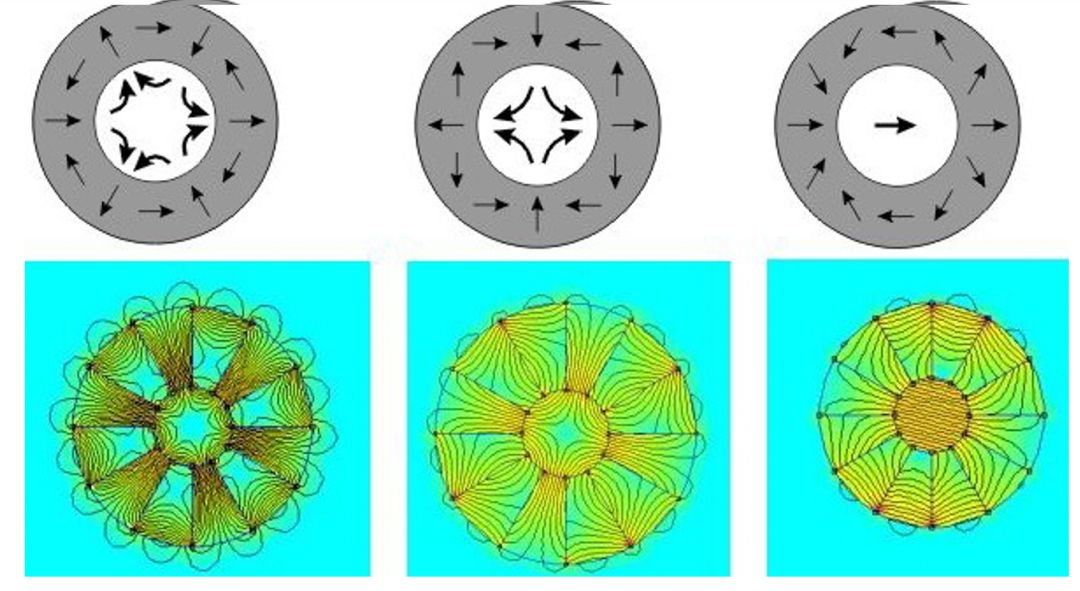
百度百科:Halbach Array一般指海尔贝克阵列,见 海尔贝克阵列_百度百科 (baidu.com)
海尔贝克阵列(Halbach Array)是一种磁体结构,是工程上的近似理想结构,目标是用最少量的磁体产生最强的磁场。1979 年,美国学者Klaus Halbach做电子加速实验时,发现了这种特殊的永磁铁结构,并逐步完善这种结构,最终形成了所谓的“Halbach”磁铁。
维基百科:Halbach array – Wikipedia
A Halbach array is a special arrangement of permanent magnets that augments the magnetic field on one side of the array while cancelling the field to near zero on the other side.[1][2] This is achieved by having a spatially rotating pattern of magnetisation.
The rotating pattern of permanent magnets (on the front face; on the left, up, right, down) can be continued indefinitely and have the same effect. The effect of this arrangement is roughly similar to many horseshoe magnets placed adjacent to each other, with similar poles touching.
The principle was first invented by James (Jim) M. Winey of Magnepan in 1970, for the ideal case of continuously rotating magnetization, induced by a one-sided stripe-shaped coil.[3]
The effect was also discovered by John C. Mallinson in 1973, and these “one-sided flux” structures were initially described by him as a “curiosity”, although at the time he recognized from this discovery the potential for significant improvements in magnetic tape technology.[4]
Physicist Klaus Halbach, while at the Lawrence Berkeley National Laboratory during the 1980s, independently invented the Halbach array to focus particle accelerator beams.[5]
Applications[edit]
The advantages of one-sided flux distributions are twofold:
- The field is twice as large on the side on which the flux is confined (in the idealized case).
- There is no stray field produced (in the ideal case) on the opposite side. This helps with field confinement, usually a problem in the design of magnetic structures.
Although one-sided flux distributions may seem somewhat abstract, they have a surprising number of applications ranging from the refrigerator magnet through industrial applications such as the brushless DC motor, voice coils,[7] magnetic drug targeting[8] to high-tech applications such as wiggler magnets used in particle accelerators and free-electron lasers.
This device is also a key component of the Inductrack Maglev train[9] and Inductrack rocket-launch system,[10] wherein the Halbach array repels loops of wire that form the track after the train has been accelerated to a speed able to lift.
The simplest example of a one-sided flux magnet is a refrigerator magnet. These are usually composed of powdered ferrite in a binder such as plastic or rubber. The extruded magnet is exposed to a rotating field giving the ferrite particles in the magnetic compound a magnetization resulting in a one-sided flux distribution. This distribution increases the holding force of the magnet when placed on a permeable surface, compared to the holding force from, say, a uniform magnetization of the magnetic compound.
Scaling up this design and adding a top sheet gives a wiggler magnet, used in synchrotrons and free-electron lasers. Wiggler magnets wiggle, or oscillate, an electron beam perpendicular to the magnetic field. As the electrons are undergoing acceleration, they radiate electromagnetic energy in their flight direction, and as they interact with the light already emitted, photons along its line are emitted in phase, resulting in a “laser-like” monochromatic and coherent beam.
The design shown above is usually known as a Halbach wiggler. The magnetization vectors in the magnetized sheets rotate in the opposite senses to each other; above, the top sheet\’s magnetization vector rotates clockwise, and the bottom sheet\’s magnetization vector rotates counter-clockwise. This design is chosen so that the x components of the magnetic fields from the sheets cancel, and the y components reinforce, so that the field is given by
where k is the wavenumber of the magnetic sheet given by the spacing between magnetic blocks with the same magnetization vector.
These cylindrical structures are used in devices such as brushless AC motors, magnetic couplings and high-field cylinders. Both brushless motors and coupling devices use multipole field arrangements:
- Brushless motors typically use cylindrical designs in which all the flux is confined to the centre of the bore (such as k = 4 above, a 6-pole rotor) with the AC coils also contained within the bore. Such self-shielding motors designs are more efficient and produce higher torque than conventional motor designs.
- Magnetic-coupling devices transmit torque through magnetically transparent barriers (that is, the barrier is non-magnetic or is magnetic but not affected by an applied magnetic field), for instance, between sealed containers or pressurised vessels. The optimal torque couplings consists of a pair of coaxially nested cylinders with opposite k and −k flux magnetization patterns, as this configuration is the only system for infinitely long cylinders that produces a torque.[14] In the lowest-energy state, the outer flux of the inner cylinder exactly matches the internal flux of the outer cylinder. Rotating one cylinder relative to the other from this state results in a restoring torque.

海尔贝克阵列(Halbach Array)_上海骏材_新浪博客 (sina.com.cn)
Klaus Halbach(左)在探讨永磁阵列模型。
圆环阵列
海尔贝克阵列 Halbach Array_磁体 (sohu.com)
海尔贝克阵列的形式与应用
- 直线阵列
直线型是最基础的Halbach阵列组成形式,这种阵列磁体可视为一种径向阵列与切向阵列的结合,如下图。

直线型Halbach阵列目前主要应用于直线电机。磁悬浮列车的悬浮原理是运动磁体和它在导体中感应电流产生的磁场相互作用产生悬浮力,同时伴有磁阻力,提高浮力与阻力比是改善悬浮系统性能的关键,这就要求车载磁体重量轻、磁场强、磁场均匀、可靠性高。采用Halbach阵列水平安装在车体中央,与轨道中央的绕组作用产生推进力,以较少的磁体用量达到磁场最大化,而另一侧磁场较少,可以乘客避免暴露在强磁场之中。
- 环形阵列
环形Halbach阵列可视为将直线型Halbach阵列首尾相接组合而形成圆环形状。

在永磁电机中,使用Halbach阵列结构的永磁电机较传统永磁电机具有更接近正弦分布的气隙磁场,在永磁材料用量相同的情况下,Halbach永磁电机气隙磁密度更大,铁损较小。此外Halbach圆环阵列还广泛应用于永磁轴承、磁制冷设备和磁共振等设备中。
海尔贝克阵列的制作和生产方法
方法1:根据阵列的拓扑结构,使用磁体胶将预先已充磁的磁体段粘连在一起,因各磁体段之间的互斥力很强,所以在粘连的时候要使用模具进行夹紧。该方法制造效率较低,但较容易实现,比较适合实验室研究阶段使用。
方法2:首先利用充模或压模的方法制造一个完整的磁体,然后在一个特制的夹具中进行充磁,采用该方法加工出的阵列结构和下图类似,这种方法加工效率高,比较容易实现批量化生产。但需要专门设计充磁夹具和制定充磁工艺。

方法3:利用特定形状的绕组阵列来实现Halbach型磁场分布,如下图。


